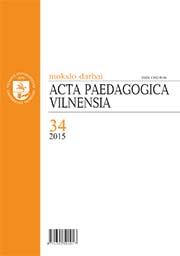Aukštesniųjų klasių mokinių muzikinio kūrybiškumo ugdymas muzikinėmis kompiuterinėmis technologijomis: muzikos mokytojų patirtis
Development of musical creativity of senior pupils using musical computer technologies (mct): experience of music teachers
Author(s): Sandra Rimkutė-Jankuvienė, Rūta GirdzijauskienėSubject(s): Education, Music, Evaluation research, ICT Information and Communications Technologies
Published by: Vilniaus Universiteto Leidykla
Keywords: musical creativity; musical computer technology (CCS);
Summary/Abstract: The application of information and communication technologies (ICT) in different Lithuanian and global education contexts has been analyzed for several decades. Scientific works present insights on how the ICT might be applied not only in the general education context, but also among specific training subjects. Specialized ICT means are being used in teaching music: sound and image technologies, special software for music training, self-studying, and composing. Therefore, besides the ICT, the concept of the music computer technologies is used. The music computer technologies (hereinafter MCT) is a multi-purpose electronic computer equipment with the installed software for music composition, editing, and other music-related activities as well as training. It is the tools used for listening to music, performing, creating it or otherwise used practically which open new possibilities for teachers and students of participation in the creative musical activity. Scientific works exploring the specifics of the MCT application in the music education process indicate that display software and sound reconstruction equipment help to know the global music culture in an imaginative, interesting, and integrated way, the composition software provides all students with the possibility to try themselves in music creation. Although the significance of the MCT application in the music education process is recognized, still organization of music creational activities using the MCT as well as the recognition of musical creativity raise many challenges to educators. The Planning and organization of the educational process, selection of education contents and methods, and the character of the evaluation system depend on the teacher’s ability to recognize a creative pupil, what music creativity manifestation he / she attributes to the pupil. However, there is still a lack of the research that would reveal the peculiarities of the development of senior class pupils’ musical creativity and MCT application in the practice of musical education. Therefore, planning the empirical investigation, the essential issues were raised: how musical creativity of senior class pupils using the MCT is recognized, how teachers of music plan and organize the MCT process of the development of senior class pupils’ musical creativity. DEVELOPMENT OF MUSICAL CREATIVITY OF SENIOR PUPILS USING MUSICAL COMPUTER TECHNOLOGIES (MCT): EXPERIENCE OF MUSIC TEACHERS Sandra Rimkutė-Jankuvienė, Rūta Girdzijauskienė Summary Object of the research – senior pupils’ musical creativity and its development by using musical computer technologies (MCT). Purpose of the research – to reveal the peculiarities of senior pupils’ musical creativity and its development by using the MCT on the basis of teachers’ experience. Methods of the research – analysis of scientific literature, interview with teachers of music. Methodology of the research. The interview with 10 teachers of music made during the research should be attributed to the type of half-structured, otherwise called directional, interview. The questions to the teachers of music were divided into two groups. The first group helped to find out how music teachers recognize the creativity of senior class pupils. The teachers were inquired what features they base on to recognize the musical creativity of the pupils using the MCT. The second group questions helped to find out how teachers plan and organize the process of the development of senior pupils’ musical creativity by using the MCT. Summation of the research results. The musical creativity of senior class pupils using the MCT is recognized according to the process and result of music creation. Pupils’ musical creativity expression in the process of music creation is related to the character of their musical and MCT work experience as well as to their involvement into musical creational activity. The musical and MCT work experience facilitates the process of creation, and the musical creation by the pupils who acquire it is typical of an unconventional form of the piece, variety of musical instruments applied, untraditional music style, and individual means of expression. The products of the pupils who acquire less experience are based on models provided by the musical software and samples of music encountered in various social contexts. The following features characterize pupils’ musical creativity expression according to the result of music creation: an idea of the piece and originality of its implementation ways, the completeness and unconventionality of the music form, the variety of music style selection, expediency of musical expression means, and their inter-tune. The informants understand the process of musical creativity development as an individualized, 104 consistent and purposeful process. The teachers refer to the fact what knowledge students are short of (language of music, composing technique, MCT), encourage them to share their knowledge, experience, to discuss issues, and to search for solutions. The pupils who have experience in music analysis and MCT application are provided with the conditions to form their music targets on their own, the freedom to decide what and how they want to create. The teacher becomes a consultant, assistant who renders special musical or creation technique-related knowledge. Evaluating the pupils’ creation process and its results, an idiographic perspective is predominant, when an individual advancement and efforts of a student are being discussed. While evaluating, special attention is paid to group discussions, analysis and evaluation of one’sown music compositions and those of classmates.
Journal: Acta Paedagogica Vilnensia
- Issue Year: 2015
- Issue No: 34
- Page Range: 89-104
- Page Count: 16
- Language: Lithuanian

